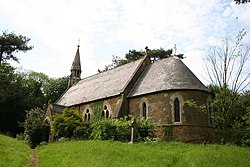Wold Newton, Lincolnshire
| Wold Newton | |
| Lincolnshire | |
|---|---|
 All Hallows' Church, Wold Newton | |
| Location | |
| Grid reference: | TF243968 |
| Location: | 53°27’13"N, 0°7’44"W |
| Data | |
| Post town: | Market Rasen |
| Postcode: | LN8 |
| Local Government | |
| Council: | North East Lincolnshire |
| Parliamentary constituency: |
Cleethorpes |
Wold Newton is a village in the north of Lincolnshire, in Lindsey, the county's northern part. The village is just over a mile west of the A18 road, part, seven miles north-west of Louth, and almost ten miles north-east of Market Rasen.
History and archaeology
Studies of cropmarks suggest a range ancient sites in the parish, such as prehistoric or Roman enclosures; boundaries; trackways and the remains of a settlement consisting of tofts, crofts, buildings, boundaries hollow ways. A Roman coin, a silver denarius of Trajan dated to 114–117 AD has been found.[1][2]
A set of Anglo Saxon urns were found in a field in 1828 by road workers quarrying gravel. The site was subsequently excavated by the Rev. Dr. Oliver, Vicar of Scopwick, Lincoln, who reported at a meeting of The Archaeological Institute the discovery of a:
large tumulus, spreading over about three acres, and composed entirely of gravel.... Upon this tumulus was ... a long barrow ... in which more than twenty urns, of various forms, had been deposited, arranged in a line, the whole length of the mound, the mouths upwards,. They lay about three feet from the surface, and at irregular distances, some being close together, others three or four feet apart. Three only were preserved, and they were sent ... to the Society of Antiquaries of Scotland. They were fabricated without the use of the lathe, and rudely scored with lines and circles; these urns were half filled with ashes, calcined bones, and black greasy earth. [He supposed] that this tumulus had been a family burying-place of some British chief, the larger mound being possibly the cemetery of his tribe.[3]
The Grimsby to Wold Newton Turnpike Act was passed in 1765. The Wold Newton turnpike, the only turnpike out of Grimsby, provided a route across the low-lying marshland surrounding Grimsby up on to the dry lands of the Wolds, ending at Wold Newton church. From Wold Newton, the traveller as left with the existing, unimproved roads. There were toll gates at Brigsley Beck, where the toll house still stands on the north side of the road on the west side of the beck.
Land ownership
Immediately after the Norman conquest the parish was split between three feudal lords: the Bishop of Durham, Earl Alan and a group of thanes including one Sortibrand. In turn they had between them five tenants: Grinchel, Walbert, Ingemund, Wimund and Justan.
From the 18th century, the Earls of Yarborough owned Wold Newton from the late 18th century until the agricultural depression towards the end of the 19th century, when the estate was sold, to pay off debts,[4] to one of their Wold Newton tenants, William Wright.
Church
The parish church, the Church of All Hallows, was dedicated in 1862. It is the fifth church on the site. Two simple buildings preceded what was probably the finest church, built in the 12th century. This church was destroyed during the Civil War when parliamentary troops came from Kingston upon Hull and a skirmish ensued in the churchyard.
The font, which dates from the 14th century, is all that remains of the third church. A simple building served as the church from the restoration of the monarchy in 1660 until the present church was built in 1861–62 by James Fowler,[5] paid for in part by a grant from the Incorporated Society for Promoting the Enlargement, Building and Repairing of Churches and Chapels.
Outside links
| ("Wikimedia Commons" has material about Wold Newton, Lincolnshire) |
References
- ↑ English Heritage NMR Monument Report, 18 June 2002, pp. 12, 16–18, 22–30
- ↑ Phillips, Patricia; Archaeology and Landscape Studies in North Lincolnshire, vol 2, British Archaeological Reports (1989) ISBN 978-0-86054-639-9
- ↑ Archaeological Journal, Proceedings at Meetings of the Archaeological Institute, volume 6, (1849).
- ↑ Mitson, A. (1998); Women's History Review – An exchange of letters: estate management and Lady Yarborough, 7:4, pp. 547–566.
- ↑ National Heritage List 1161343: Church of All Hallows (Grade II listing)
